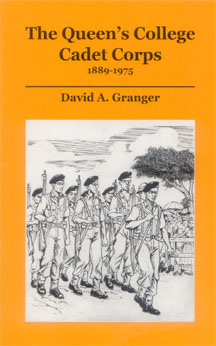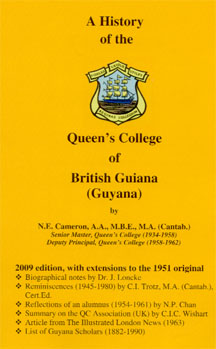Queen’s College in print
Norman E. Cameron, A History of the Queen’s College of British Guiana (reprint). Toronto: Vantage Systems, 2009; Laurence Clarke, Queen’s College of Guyana. Records of a Tradition of Excellence, 1844-1994. Gaborone: Penrose Book Printers, 1994; David A. Granger, The Queen’s College Cadet Corps, 1889-1975, Georgetown: Free Press, 2009; and Winston Mc Gowan, A Concise History of Queen’s College, 1844-2009. Georgetown: Free Press, 2009.
Queen’s College is justifiably jealous of its tradition and reputation. It has educated several presidents, prime ministers, chancellors of the judiciary, chief justices, high court judges and thousands of academics, bureaucrats, businessmen, diplomats, scientists and other professionals over the past 165 years.
Queen’s is Guyana’s oldest and best secondary school and has a long literary legacy. The College opened its library in 1880 – even before the National Library was established. The next year, it published the College newspaper called Our College Gazette and this was followed by the QC Gazette, the Queen’s Chronicle and, in 1950, by the QC Lictor newspaper. The Queen’s College Magazine appeared annually almost from about 1912 to the 1974-76 edition.
With such a rich record of printed sources, it is surprising that greater efforts were not made to publish a comprehensive history of the College. For the first 150 years of its existence, the College’s collective memory was preserved mainly in Norman Cameron’s slim, 143-page History. Out of respect for the venerable master, perhaps, no one seemed inclined to attempt to improve or add to it over the years.
This changed when a catastrophic fire destroyed a substantial part of the building and incinerated valuable official records in 1997. Together with perceptions that a slide in standards of individual conduct was eroding the old values, the publication and reissue of several new books was considered urgently before the memory of the College’s traditions was erased completely by time or destroyed by the twin ravages of fire and flood.
This year’s alumni convention to mark the College’s 165th anniversary was the occasion for the publication and launching of three historical monographs – Norman Cameron’s A History of the Queen’s College of British Guiana; David Granger’s The Queen’s College Cadet Corps and Winston Mc Gowan’s A Concise History of Queen’s College. A fourth – Laurence Clarke’s Queen’s College of Guyana: Records of a Tradition of Excellence – should be added although it was launched at the 150th anniversary convention 15 years ago. All four books should be considered as part of a single corpus of literature on the College.

Norman Cameron’s A History of the Queen’s College of British Guiana was the first and is still the most authoritative history of the College although it was published 58 years ago. Cameron himself had a splendid career at Queen’s where he won the Guiana Scholarship, excelled in sport, returned to join the staff and retired eventually as Deputy Headmaster.
His mathematician’s eye for precision, his love of language and his faculty of writing economically combined with his long familiarity with the College as both a student and a member of staff to produce a slim volume that is packed with facts derived from primary sources many of which are now lost. Writing in the colonial era, he was able to access the records of the Archives of the Public Buildings (the forerunner of the National Archives); the Education Department (forerunner of the Ministry of Education); the Royal Agricultural and Commercial Society and the Bishop’s High School and Queen’s College.
Cameron’s History begins at the College’s inception in 1844 and, although it seems that he intended to publish his book in time for the centenary celebrations in 1944, was not able to do so. Nothing was lost in waiting for seven more years. It is the single most valuable source of information about the College.
The new edition, however, is more than a reprint of the original book. It is laden with half dozen additional, magazine-style sections including ‘Biographical notes’ on Norman Cameron by Joycelynne Loncke; ‘Reminiscences’ by Clarence Trotz; ‘Reflections’ by N Chan; ‘Summary on the QC Association (UK) by Charles Wishart; an article from ‘The London Illustrated News (1963)’ and a ‘List of Guyana Scholars (1882-1990). These supplements, though interesting, were not Cameron’s work. They could have been printed more gainfully in a souvenir magazine than in a serious historical text.
Laurence Clarke’s Queen’s College of Guyana: Records of a Tradition of Excellence, not surprisingly, was inspired by Cameron’s opus. Clarke, also an alumnus, saw the need to supplement Cameron’s book which, though timeless, had become rare. Clarke, towards the end of his septennium at the College in 1969, therefore set out to record systematically key elements in the “emergence, growth, development and history of excellence” by compiling the records beyond those covered by Cameron.
Clarke’s 313-page tome, essentially, is a reference book. It serves as an excellent statistical companion to Cameron’s narrative. It covers the evolution of the College’s organisation and structure including lists of principals, prefects and heads of houses and academic records including exhibition and scholarship winners, outstanding results at Oxford and Cambridge, London University and Caribbean Examination Council and special prize winners.

The sections on ‘Clubs and Societies’ and ‘Sports and Games,’ respectively, provide a panoramic picture of the vast array of extracurricular activities in which students participated. These ranged from Art, Bee-Keeping, Cadets, Co-operative (long before the word became a political cliché), Debating, Drama, History, Photography, Scouting and various religious groups, among others. The range of sports included Athletics, Badminton, Chess, Cricket, Swimming and Table Tennis.
Winston Mc Gowan’s A Concise History of Queen’s College, perhaps, is the most up-to-date and ‘readable’ of the three histories. Considering the widespread ignorance of the College’s traditions, reputation and culture, the publishers had in mind producing a concise but comprehensive history that would be accessible to all new entrants – both staff and students. Mc Gowan’s monograph fits the bill perfectly
.
The book, an updated version of the long essay first published in the Queen’s College Sequicentennial Souvenir Magazine in 1994, now covers the College’s entire 165-year history. It also contains a very useful section on historical ‘Landmarks’ and is well illustrated with photographs of the iconic founder of the College Bishop William Piercy Austin, various premises over the last 129 years and staff and students and assemblies over the last 63 years.
David Granger’s The Queen’s College Cadet Corps, alone amidst the three ‘general’ histories, deals with only one specific part of the College’s long history – the Cadet Corps. The Corps was one of the earliest in the Commonwealth Caribbean to be established. It was one of the liveliest while it lasted and, regrettably, the only one to collapse.
One of the Cadet Corps’ unintended accomplishments was to furnish a significant number of members of the immediate post-Independence military officer corps. At different times, the Chief of Staff and Commander of the Guyana Defence Force, the Commandant of the Guyana People’s Militia and the Director General of the Guyana National Service were all former members of the QC Cadet Corps. Established in 1889, the Corps flourished for 86 years until the administration’s decision to merge it with the then recently-formed Guyana National Service led to its sudden extinction. The book recaptures the nostalgia of training and the camaraderie that it engendered. Like Mc Gowan’s Concise History, Granger’s Cadet Corps is a simple monograph meant to be read by young students on entry to the College.
When the College celebrated its 150th anniversary in 1994, alumni and students combined their talent to publish a souvenir magazine. Later, other periodicals were published. As a result, there are three important ‘periodicals’ – Queen’s College Sesquicentennial Souvenir Magazine, 1994; The 2000 Reunion of the Queen’s College of Guyana Alumni Association and The ICQC Newsletter – that complement these four books. Their publication was an achievement of various alumni associations and, inevitably, their content is dominated by reminiscences by alumni, most often males, who attended the College before co-education was introduced. For this reason, they are valuable sources of historical information.
As Mc Gowan pointed out in his Concise History “The whole tone of the school is permeated by the tradition and reputation built up over the years.” These seven publications help to explain the role that “tradition and reputation” played in moulding the institution which made such a significant impact not only on the individual lives of the students but also on the nation.
